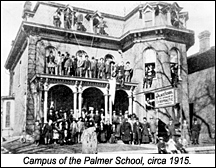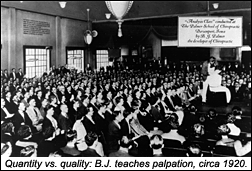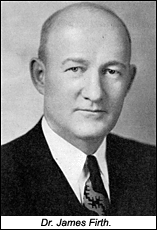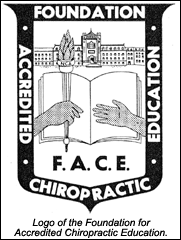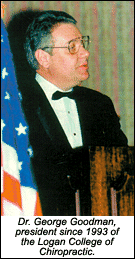Dr. Palmer was not content to rest on his laurels, however. Even before the federal tuition benefits from the Veterans Bureau swelled the ranks of the student body to 3,000 in the aftermath of World War I,3 B.J. had diversified his revenue stream. Early on, he captured the largest share of the market for chiropractic equipment, and established the PSC print shop, which turned out millions of pamphlets, postcards, and advertising tracts. B.J. dived into the new medium of radio in 1922, first purchasing WOC, and later WHO,4 and also dabbling in the emerging field of moving pictures.1 When hard times came to the PSC in the wake of the neurocalometer fiasco,5 and the U.S. stock market's plummet in 1929, the Palmer enterprises expanded to include a roller skating rink and mop factory. The PSC cafeteria was open to the public, and reportedly enjoyed a lively business in those early days. B.J. was one "hell of an entrepreneur" (although Mabel reportedly kept the books), and was not satisfied with tuition alone.
Most early chiropractic colleges followed Palmer's lead, at least in terms of their corporate structures: proprietary. (A noteworthy early exception was the Cleveland Chiropractic College of Kansas City, chartered in 1922 as a nonprofit institution.) Unlike the PSC, however, most early chiropractic educational institutions depended almost exclusively on tuition (and fees from their college clinics) to meet annual operating budgets (AOBs). When veterans' benefits expired in the 1920s, the 80-plus schools6 that had sprung up withered (most closed), and those that remained imploded.7 The depression years were a tough time for chiropractic schools and the nation as a whole, and it was not until the post-WWII era, with the tuition dollars provided under the G.I. Bill through the Veterans Administration, that the chiropractic colleges were able to breathe easier again.
The profession has noted with justifiable pride that its educational enterprise has been created and sustained largely without the assistance of government and taxpayer dollars. (Educational benefits for veterans and federally guaranteed student loans should not be misconstrued as grants to chiropractic schools; they are revenues that come to the schools in the form of tuition.) However, the schools have probably reached an apex in terms of what can be accomplished, based largely on tuition as the primary revenue source.
Leaders of the National Chiropractic Association's Council on Education (CoE; ancestor of today's CCE) explicitly recognized the formidable limitations of tuition-driven institutions in the 1950s. James Firth, DC, president of the Lincoln Chiropractic College in Indianapolis, suggested that "the lower one-third of the students in all chiropractic colleges represented the endowment for the upper two-thirds."8 In other words, heavy tuition dependence required the schools to accept a number of less-than-desirable individuals into chiropractic training, in order to sustain the institutions and to meet the requirements of the AOBs. There were other consequences of excessive tuition dependence: The choice of faculty members was restricted by the dollars available for their employment, and the pace of upgrading of college facilities was hampered by the schools' limited revenue sources. Research was viewed as a luxury the colleges could ill afford.9
To be sure, chiropractic colleges have always attracted some exceptional individuals as students and faculty members. However, the schools have not enjoyed the option to be highly selective in who was admitted and who was employed; the bills must be paid. Recognizing these limitations, and concerned for the adequate preparation of chiropractic students and for the legitimacy of the profession, efforts to raise admissions standards have been underway for 50 years. Unfortunately, when "preprofessional" (liberal arts college coursework) requirements were first introduced in the 1950s by CoE-accredited schools (LACC, National, Western States), competition from schools that made no such demands on applicants produced a severe decline in enrollment among the innovator institutions.10 Declining enrollments meant declining tuition revenues, and the preprofessional requirements were waived, not to be seen again until the late 1960s, as the CoE sought recognition from the U.S. Office of Education. (It should also be noted that raising admissions criteria is not equivalent to exercising greater selectivity in admissions; greater selectivity requires lessened tuition dependence.)
Many in the profession's early years had anticipated that the CoE's transformation of chiropractic schools from proprietary to nonprofit status would serve to alleviate the financial strains on chiropractic education. Although the personal-profit motive was eliminated by these corporate conversions, this in itself did little or nothing to diversify the sources of revenue available to the colleges. When the American Chiropractic Association (ACA) was organized in 1964, one of its early and most fateful actions was to commit 40 percent of membership dues to the upgrading of chiropractic schools, in an effort to support its CoE and the quest for federal recognition of chiropractic education. (Funds were disbursed via the Foundation for Accredited Chiropractic Education and its successor, today's FCER.) These "grants-in-aid" to the CoE-accredited institutions were just enough to do the trick (CCE was recognized by the USOE in 1974), but not sufficient to alter the fundamental financial dynamic of chiropractic education in America: tuition dependence. Several of the colleges accredited by the ACA's CoE were unable to persevere (Chiropractic Institute of New York; Lincoln Chiropractic College), and merged with the National College.
Today, the situation is largely unchanged. To the best of my knowledge, the typical chiropractic school in the United States is 65 percent to 90 percent tuition-dependent for its AOB, and spends less than 5 percent of its budget on research. (By way of contrast, the typical allopathic school is 5 percent to 15 percent tuition-dependent, and spends more than half of its budget on research. Figures for the financing of allopathic schools are published in JAMA in the autumn each year.) A few colleges receive capitation funds (e.g., National University of Health Sciences) or other dollars from state governments, and one or two colleges have received federal grants for facilities construction. The Palmer College has been the recipient of money from the National Institutes of Health for the development of its consortial research center, and the Logan College has done a commendable job in recent years in attracting corporate philanthropy.11 (My apologies for any noteworthy fundraising successes I've failed to mention.) Chiro schools in the U.S. have collectively received about $10 million in research grants from the federal government during the past decade, in contrast to the estimated $11 billion in federal funds for research and education received annually by allopathic colleges. Widespread alumni support is not what it could be at some of the chiropractic schools, although large, generous gifts from a few have helped to augment total giving figures for some colleges.
All in all, however, chiropractic education in the United States continues to be a poverty-stricken, tuition-driven enterprise. We may not like to hear this, but it is such a fundamental reality that should not be ignored. Competition among students for admission to U.S. chiropractic colleges is virtually nonexistent; it exists primarily among the admissions directors of the schools. "Academic incest" and the employment of relatively low-paid, recent graduates (some of whom undoubtedly become fine clinician-teachers) is all too common. The decline in enrollments at U.S. chiropractic schools in recent years meant drastic cuts in personnel at some of our colleges, a reflection of excessive tuition dependence. A few schools have sought to diversify revenue streams by introducing training programs in allied health fields, such as acupuncture, massage and naturopathy. This is all well and good (depending on one's "philosophy"), but it is still a tuition-driven strategy.
What can be done to alter or alleviate the century-long tradition of excessive tuition dependence of chiropractic education in America? One possibility is exemplified by the proliferation of foreign chiropractic schools, several of which are state-supported, and better yet, state-university-based chiropractic programs (e.g., in Australia, Britain, Canada, Denmark and South Africa). The support from the Lincoln College Education & Research Trust in promoting the formation of a chiropractic college (and a biomechanics research laboratory) within Florida State University (FSU) is highly commendable, and if we cease attempting to kill this important innovation, it may yet get off the ground. Certainly, if the 50-plus jurisdictions in the United States have seen fit to grant licensure to chiropractors, they should also be expected to aid in the training of chiropractic doctors. This is not to suggest that all states should have a chiropractic college, or that all chiropractic colleges should be state-university-based; however, the internal resistance to this significant advance for chiropractic education boggles the mind!
Other important steps can be taken to relieve tuition dependence. Nonprofit corporations are permitted to operate profit-generating business consistent with their mission statements. For example, chiropractic colleges presumably could run nursing homes, health food stores, publishing houses, or Internet-based vending of health care equipment and technology. In the case of a college-operated nursing home, the return on investment would presumably go beyond dollars to include an expanded patient base for our interns at the frequently underutilized college clinics. Undoubtedly, there are other profitable and permissible ventures that I cannot even imagine.
Where there is a will, it is said, there is a way (or maybe several ways). Surely, this is an area in which we would do well to follow B.J.'s lead: to find multiple sources of additional income, nontuition revenue, for the support of chiropractic education. The first step, I suspect, is to recognize and acknowledge that there is a problem - one that belongs to the schools and to the profession-at-large in the United States.
References
- Keating JC. B.J. of Davenport: the Early Years of Chiropractic. Davenport IA: Association for the History of Chiropractic, 1997.
- Flexner, Abraham. Medical Education in the United States and Canada. New York: Carnegie Foundation, 1910 (reprinted 1967, Times/Arno Press, New York).
- Keating JC. The influence of World War I upon the chiropractic profession. Journal of Chiropractic Huma nities 1994; 4:36-55.
- Keating JC. Shhh!!! ... Radiophone station WOC is on the air: chiropractic broadcasting, 1922-1935. European Journal of Chiropractic Aug. 1995;43(2):21-37.
- Keating JC. Introducing the neurocalometer: a view from the Fountain Head. Journal of the Canadian Chiropractic Association Sept. 1991; 35(3):165-78.
- Ferguson AC, Wiese G. How many chiropractic schools? An analysis of institutions that offered the D.C. degree. Chiropractic History July 1988;8(1):26-36.
- Keating JC, Callender AK, Cleveland CS. A History of Chiropractic Education in North America: Report to the Council on Chiropractic Education. Davenport IA: Association for the History of Chiropractic, 1998.
- Minutes of the mid-year meeting of the National Council on Education of the National Chiropractic Association, February 9-11, 1955, Astor Hotel, New York City (Archives of the Council on Chiropractic Education).
- Budden WA. Comments on a proposal. National Chiropractic Journal 1948 (Dec);18(12):24, 60.
- Keating JC, Phillips RB (Eds.): A History of Los Angeles College of Chiropractic. Whittier, Calif: Southern California University of Health Sciences, 2001.
- Logan College of Chiropractic timeline: 1993-2003. Logan Speaks February 2003:3-4.
Joseph Keating Jr., PhD
Phoenix, Arizona
Click here for previous articles by Joseph Keating Jr., PhD.






